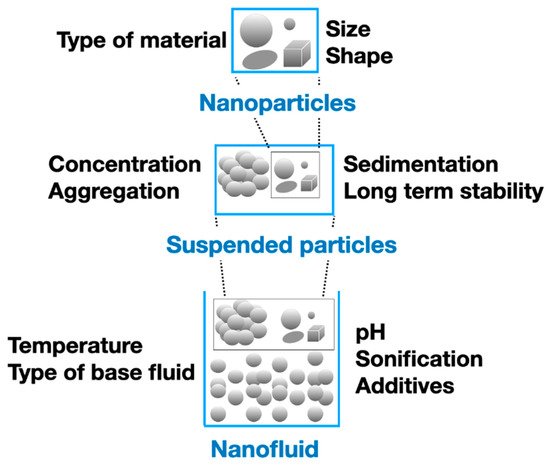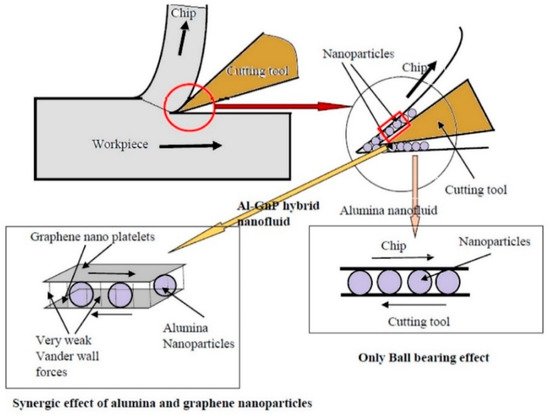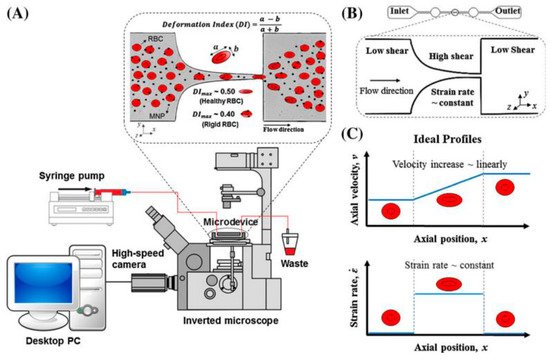The nanofluids (NFs) are known as a colloidal suspension where nanoparticles (NPs) are dispersed in conventional base fluids (BFs). This suspension has been frequently used to improve the heat transfer (HT) capacity of a fluid by studying their thermophysical properties. The NFs thermal properties and their applications are being used in different fields of engineering, ranging from machining to renewable energies. In machining, NFs play a prominent role in the processes of turning, milling, drilling, and grinding, being responsible for their optimization as well as improving the useful life of the tools and reducing costs. In the solar energy field, NFs have been used in the thermal management of the panels, controlling and homogenizing the operating temperature of these systems. In the biomedical area, the advantages of using NFs come from the treatment of cancer cells, the development of vaccines before the improvement of diagnostic imaging, and many others.
1. Introduction
Nanofluids (NFs) are a colloidal mixture of nanoparticles (NP) (1–100 nm) suspended in a fluid base [
1,
2]. NPs can be metals, oxides, carbon-based nanomaterials, carbides, or polymers, while the most common base fluids are water, oil, and ethylene glycol [
3,
4]. The main application of NFs is in heat transfer. The idea of using small solid particles in a liquid to improve thermal efficiency has been known since the beginning of the 20th century [
5], but the first to consider using nanoscale particles for this purpose was Choi [
1,
6] in a theoretical study.
The improvement of thermal properties by adding NPs to the base fluid is due to a large specific surface area that allows a large heat exchange, Brownian movement, and the possibility of varying the properties by raw material, in addition to permitting a more efficient use of pumps requiring smaller cooling systems [
2]. To obtain the NPs, two techniques are used, the one-step and two-step methods [
1,
5,
8]. There are applications of nanofluids in various heat exchange systems for engines, solar panels, nuclear, and space areas, as well as their use in biomedical, machining, and energy storage [
2].The greatest interest to use is the potential improvement in the heat transfer properties of current fluids. Due to the small size of NPs, NFs are easily compatible with systems that use common fluids and, therefore, can be applied in conventional heat exchangers such as tube type, car radiators, refrigeration systems (as in Vapour Compression Refrigeration System) (VCRS) which allowed a significant increase in COP [
20].
Antibacterial properties of NPs embedded in NFs may also contribute to slowing down their deterioration and improving their heat and mass transfer rates, such as silver nanoparticles in a modified solar desalination system [
20,
21].
NFs and NPs with thermoelectric effect allow the creation of electricity and thermal energy co-generators in solar light absorption systems. In this context, the optical properties of nanofluids can also open doors to the improvement of solar collectors [
22].
NFs that use magnetic and dielectric NPs that are subject to electromagnetic waves allow changes in interfacial tension, changes in wettability and viscosity, and as a result makes this option a promising technology for crude oil extraction in porous media [
23].
There are many areas of study in which nanofluids have been explored [
24,
25]. In the field of machining, this technology has been used for coolants and lubricants for turning, milling, drilling, and other operations [
26].
NFs can be useful in biomedicine/medicine in processes such as magnetic separation, bioassays, drug and therapeutic administration, cancer treatments, aid in diagnosis, and estimate mechanical and rheological properties of cells [
34,
35,
36].
2. Thermal Properties
Determining the properties of NFs is complex, and several groups have obtained different results due to the large number of variables involved in the process and difficulty in relating cause and effect in the variations of parameters [
5,
37]. Furthermore, the general thermal transfer properties of each system are determined by the characteristic of the solid-liquid interface [
38].
Thermal conduction has its value affected by several parameters such as concentration, shape, size, temperature and thermal conductivity of NPs, type of base fluid, pH, sonication, and preparation technique [
3,
5]. Among recent techniques for measuring thermal conductivity, one can mention Xu et al. [
39], who implemented and improved a Steady Flow Method (SFM) based on the theory of heat transfer in laminar flow under uniform heat flow. With this, the authors could reduce the influence of natural convection in the measurement process. Thermal conduction is defined by the temperature variation of the plates when one of them is subjected to a heat source [
41]. Amiri et al. [
42] evaluated the impact of the Graphene Quantum Dot on the stability and thermal properties of a water-based solution. The results showed a significant increase in thermal conductivity when a very low concentration of NPs was placed.
Dynamic viscosity is the fluid’s resistance to shear stress, being one of the most important properties of the fluid as it demonstrates its behavior close to the limits of a solid body. The viscosity directly affects the pumpability and pressure of the system [
48].
3. Stability of Nanofluids
The low stability of nanofluids over prolonged periods and their proneness to agglomeration have made their use on a large scale difficult. The nanofluids can lose their capacity to transfer heat and have their thermophysical properties altered due to the sedimentation [
52]. The fast sedimentation of these colloidal suspensions of nanoparticles in a base fluid can also cause problems related to viscosity and flow in channels with complex geometries, mainly in microchannel systems [
53]. Traditional techniques are used to solve the problems related to the stability and sedimentation of nanofluids. The most common are: the addition of surfactants, ultrasonic vibration, and controlling the pH value of the suspensions. In addition, new techniques have been presented to improve the stability of nanofluids and increase heat transfer [
54].
The stabilization of nanofluids is achieved by reducing surface tension and increasing the immersion of particles in the base fluid [
52]. However, the use of surfactants has some disadvantages. It interferes with the thermal properties of nanofluids compromised by increasing thermal conductivity, creating thermal resistance during the flow [
58,
59,
60]. When heated at high temperatures, it can generate foams [
58,
59], which when used during the nanoparticles’ synthesis prevents their clustering only for a certain period of time [
2,
61].
The effect of pH on the properties of nanofluids is directly related to the electrostatic forces of interaction between particles dispersed in the base fluid. If the repulsion force between the particles is great, the colloidal mixture tends to stabilize through the high surface charge density generated [
58]. In addition, when repulsive forces increase, particles can move freely due to Brownian motion, thus facilitating thermal transport [
63]. However, if the electrostatic force is weak, the particles are attracted to each other, causing them to agglutinate and become sediment.
Figure 1 shows several parameters that may affect the stability of nanofluids.
Figure 1. Different features that may affect the stability of nanofluids, adapted from [
37].
4. Nanofluid Application in Machining
The cutting fluid has three main functions in metal cutting operations: lubricates the tool/workpiece interface, cools the workpiece surface and the cutting tool, and removes the chips from the cutting from the cutting region. The use of cutting fluids during machining enables the economy of tools, provides tight tolerances, and improves and protects surface properties from damages [
64]. Nevertheless, the use of cutting fluids negatively affects human health and the environment, both through their use and their disposal [
65]. As well, the cutting fluid occupies 16–20% of the cost of production in the manufacturing industry. Therefore, excessive use of cutting fluids (flood lubrication) should be limited [
66] and substituted by dry machining or minimum quantity lubrication (MQL), which can be adopted to spray cutting fluid over the tool/workpiece interface [
67]. The MQL is also known as clean manufacturing [
68]. There is a classic classification that indicates three types of cutting fluids: neat cutting oil, water-soluble fluids, and gases [
69]. The most used are the water-soluble fluids in which it is possible to add nanoparticles, thus obtaining the nanofluids. The nanofluid is a colloidal mixture of nanometer-sized, smaller than 100 nm, metallic and non-metallic particles in conventional cutting fluid [
70]. This new class of cutting fluids can be synthesized by mixing metallic, non-metallic, or carbon nanoparticles in a conventional cutting fluid which compared to the isolated fluid with the nanofluids shows better stability, good thermal conductivity, rheological properties, and no effect on pressure drop [
71]. Nanofluids possess a high level of heat extraction capabilities (thermal conductivity) over conventional cutting fluids [
2,
72]. Some researchers concluded that this enhanced thermal conductivity might be an important factor for better performance in various applications [
2].
Nanofluids are potential facilitators to reduce cost, improve tool life, and optimize the machining process. The most common machining processes in which nanofluids are used are turning, milling, drilling, and grinding. In former years, different formulations have been developed for all these machining processes. Regarding turning, Rahman et al. [
77] employed two kinds of formulated nanofluids to machine Ti-6Al-4V ELI, and concluded canola-based Al
2O
3 nanofluid with loading concentration of 0.5 vol.% led to lower surface roughness. For the high-speed turning process, Roy et al. [
78] used 3 vol% of alumina and 1 vol.% of MWCNT, resulting in a severe reduction of cutting force and specific energy. Still, MWCNT presents better efficiency related to cutting zone temperature and tool life. Sharma et al. [
79] evaluated the effect of utilizing an Al
2O
3–graphene nanoplatelets hybrid nanofluid as the cutting liquid on the tribological features in turning of AISI 304 steel. Adding the graphene nanoplatelets to the Al
2O
3 nanofluid increased the tribological characteristics.
Figure 2 illustrates the mechanism of nanoparticles entrapped between the sliding surfaces.
Figure 2. Synergic influence of the Al
2O
3 and Al
2O
3–graphene nanoplatelets trapped between the sliding surfaces. Reprinted with permission from Ref. [
79]. 2018 Elsevier.
5. Solar Panels and Collectors
Photovoltaic solar panels are devices capable of converting solar energy into electrical energy. These panels are formed out of photovoltaic cells that need sunlight for their operation. However, an excess of solar energy causes high temperatures on the surface of the cells, impairing the functionality of these systems. The problems with the high environmental temperatures from some regions of the globe have led to the development of alternative cooling techniques. The performance of the output power of a photovoltaic module decreases by 0.4% to 0.5% per 1 °C when it works above its ideal temperature, in most cases being 25 °C [
97]. To avoid the overheating of PV modules, nanofluids are potential candidates for cooling these systems. Ebaid et al. [
97] using two types of nanofluids, Al
2O
3 and TiO
2 mixed in water, for different volume flow rates and concentrations of 0.01%, 0.05%, and 0.1% by weight, the authors evaluate the performance of heat transfer for three PV panels cooled simultaneously using nanofluids, water, and natural air. Results obtained showed that nanofluids enhanced heat transfer rate much better than water or natural air.
The interest in nanofluids is due to their possibility to change the transport properties of the base fluid with the presence of suspended metallic or non-metallic nanoparticles when compared to conventional heat transfer fluids [
2,
98]. In the solar energy area, the applications of nanofluids can be found, for example, in photovoltaics thermal systems and thermal energy storage [
99]; solar collectors, solar stills, and hydrogen conversion (fuel cells) [
100]. Several researchers have shown that the thermal conductivity of nanofluids increased as a function of nanoparticles volume concentration and temperature [
101,
102,
103,
104].
6. Biomedicine
In the biomedical field, different types of nanoparticles (NPs) have been developed to improve the diagnosis and treatment of several diseases. Their small dimension makes them suitable to travel through the bloodstream and interact with cells. They have also shown biocompatibility, high charge carrier mobility, high surface-to-volume ratio, and high physicochemical stability [
119,
120]. Consequently, by modifying their shape, size, charge, and surface functional groups, the NPs can be loaded with drugs or biomarkers and specifically target certain cells or release the loaded drug in a controlled fashion. The surface-area rate of the NPs is greater than the rate of macroparticles. Subsequently, they allow the incorporation of greater quantities of drugs, targeting agents or biomarkers, to have more area of contact with the cells [
121]. Endogenous stimuli, such as pH or enzymes, exogenous stimuli, alternating magnetic fields, or near-infrared light, can also be used to control the drug release [
122]. Some NPs have also shown antibacterial or anticancer properties on their own [
123,
124], and some also can serve as a diagnostic or monitorization tool. Due to such properties, NPs have been explored to optimize the treatment of severe diseases such as cardiovascular and neurodegenerative conditions and cancer [
125,
126,
127,
128].
The main objectives for the development of nanomaterials for cancer treatment applications are [
121]:
-
Reduction of toxicity and side effects of conventional drugs by increasing their efficiency;
-
Specific binding to target cells;
-
Improvement of solubility, stability, tumor aggregation, and half-life of conventional drugs;
-
Release of the loaded drug through a stimuli-responsive mechanism;
-
Increase the area of interaction for encapsulated drugs or drugs attached to biomacromolecules;
-
Overcoming drug resistance by delivering several active agents to specific cellular target sites;
-
Overcoming biological barriers;
-
Improvement of diagnostic and imaging sensitivity;
-
Assessment of drug efficiency in real-time by linking imaging molecules and active anticancer components;
-
Contribution to the development of new vaccines;
-
Improving the diagnostic and imaging of cancer using smaller devices.
NPs from organic materials, such as proteins and lipids, were studied for cancer treatment applications due to their biocompatibility and biodegradability. Nevertheless, those NPs are not as efficient and versatile for drug delivery as the NPs from inorganic materials, such as gold, silver, iron, or zinc oxides [
135]. On the other hand, further research of the effects of the NPs circulating on the human body is still required. Not only is it important to analyze the effect on the healthy organs that are not the target of the treatment, but also to analyze the blood cells. Rodrigues et al. [
136] evaluated the effect of MNPs on the red blood cells (RBCs), as presented in
Figure 4. The authors reported a slight increase in the RBCs’ rigidity when in the presence of MNPs.
Figure 4. Schematic representation of NPs hemocompatibility evaluation. (
A) Experimental setup. (
B) Microchannel geometry. (
C) Condition profiles present in the hyperbolic channel. Reprinted from [
136]. 2016 Springer Nature.
More details about thermal properties and applications of nanofluids (NFs) can be found at the following references:
Nobrega, G.; et al. Recent Developments on the Thermal Properties, Stability and Applications of Nanofluids in Machining, Solar Energy and Biomedicine.
Appl. Sci. 2022,
12, 1115.
https://doi.org/10.3390/app12031115Gonçalves, I.; et al. Thermal Conductivity of Nanofluids: A Review on Prediction Models, Controversies and Challenges.
Appl. Sci. 2021,
11, 2525.
https://doi.org/10.3390/app11062525
This entry is adapted from the peer-reviewed paper 10.3390/app12031115



